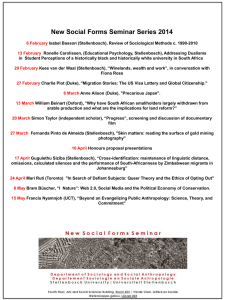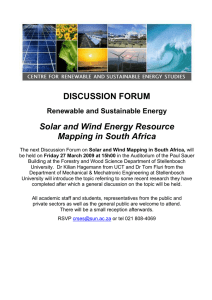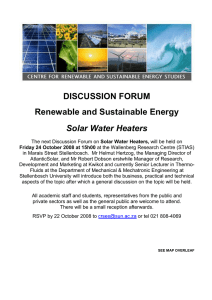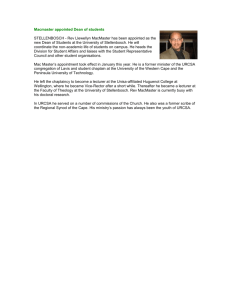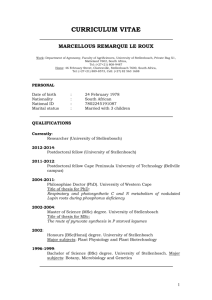Novel Energy Systems for Distributed and Mobile Power Genera;on William E. Lear University of Florida
advertisement
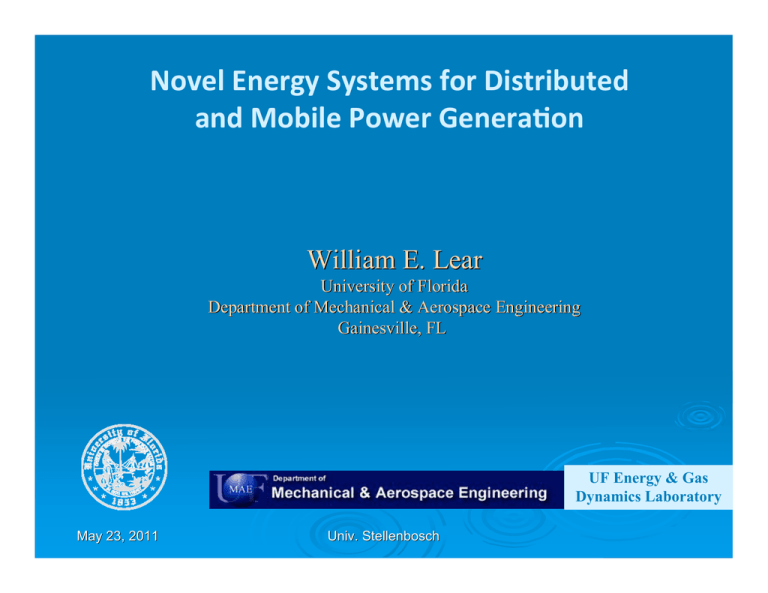
Novel Energy Systems for Distributed and Mobile Power Genera;on William E. Lear University of Florida Department of Mechanical & Aerospace Engineering Gainesville, FL UF Energy & Gas Dynamics Laboratory May 23, 2011 Univ. Stellenbosch Advanced Direct Methanol Fuel Cell for Mobile Computing University of North Florida and University of Florida May 23, 2011 Univ. Stellenbosch Objective Develop a DMFC power supply for mobile computing Use novel passive water recycling technology Enable significant simplification of DMFC systems Reduce size/weight by order of magnitude May 23, 2011 Univ. Stellenbosch DMFC Introduction May 23, 2011 Univ. Stellenbosch Conventional DMFC System Radiator heat exchanger requires large surface area Cooling Fan Fuel Cell Stack Heat Exchanger Air Filter Air Pump H+ Fuel Recirc Pump CO2 Separation Air, In Anode Cathode Condenser Dilute Fuel Reservoir Methanol Cartridge Fuel Pump Air Exhaust Cooling Fan Water Pump Water Storage Water recovery components are large and cumbersome - also do not directly aid the electrochemical process May 23, 2011 Univ. Stellenbosch Water Separator Simplified DMFC System Fuel Cell Stack UNF Membrane Air Filter Air Supply H+ CO2 Separation Air, In H2O Fuel Recirc Pump Anode Cathode Dilute Fuel Reservoir Methanol Cartridge Fuel Pump UNF Passive Water Recovery MEA Design Novel passive water recovery MEA significantly reduces the number of balance of plant components May 23, 2011 Univ. Stellenbosch Passive Water Recovery May 23, 2011 Univ. Stellenbosch Impact Baseline Membrane Electrode Assembly (MEA) provides path to system simplification and increased power and energy density, with lower system cost. Characteristic Units UNF 15 W DP3 2008 Status DOE 2010 Target UNF Proposed 20W System Design Specific Power a W / kg 35 100 41.5 a W/L 48 100 55 .6 W-hr / L 250 (1 x 100ml)b 396 (1 x 200ml)b 1000 193 (1 x 100ml) 321 (1 x 200ml) 575 (3 x 200 ml) W-hr/kg 155 (1 x 100ml) b 247 (1 x 200ml) b N/A 162 (1 x 100 ml) 307 (1 x 200 ml) 638 (3 x 200 ml) Operating Hours 1,000 hrs in single cell 5,000 2,500 Integrated System $ / Watt 11 (est. est. in volume) <3 < 10 (est. in volume) Power Density Energy Density Lifetime c Cost a Beginning of life, 30°C, sea level,50% R.H., excluding hybrid battery, power module alone Normalized from DP3 data from 150 ml cartridge to either 100ml or 200ml for comparison purposes c Lifetime measured to 80% of rated power b Normalized Marked improvement on the road towards commercialization. May 23, 2011 Univ. Stellenbosch Component Engineering Rigs Cooling Fan Test Stand: Used to measure the performance and efficiency of cathode fans. Electric Motor Dyno: Used to measure the performance and efficiency of electric motors for pumps and fans. May 23, 2011 Univ. Stellenbosch Anode Recirculation Pump May 23, 2011 Univ. Stellenbosch Methanol Injection Pump Grey area indicates system load curve. May 23, 2011 Univ. Stellenbosch Cathode Reactant/Cooling Fan May 23, 2011 Univ. Stellenbosch May 23, 2011 Univ. Stellenbosch May 23, 2011 Univ. Stellenbosch System Engineering: Brassboard (Unpackaged System) Each brassboard has over 500 hours of operation. May 23, 2011 Univ. Stellenbosch May 23, 2011 Univ. Stellenbosch System Engineering: Packaged System May 23, 2011 Univ. Stellenbosch System Engineering: Packaged System System with Fuel Cartridge System without Fuel Cartridge May 23, 2011 Univ. Stellenbosch System Validation Testing: Continuous Operation Consistent brassboard operation . May 23, 2011 Univ. Stellenbosch System Validation Testing: Off-State Degredation Brassboard performance degradation two orders of magnitude less with continuous operation. May 23, 2011 Univ. Stellenbosch Questions May 23, 2011 Univ. Stellenbosch
